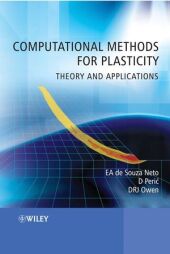Computational Methods for Plasticity - Theory and Applications
| Verlag | Wiley & Sons |
| Auflage | 2008 |
| Seiten | 816 |
| Format | 24,4 cm |
| Gewicht | 1508 g |
| Artikeltyp | Englisches Buch |
| ISBN-10 | 0470694521 |
| EAN | 9780470694527 |
| Bestell-Nr | 47069452EA |
Using computers to simulate the behavior of engineering materials considered plastic is vital in the work of research engineers and scientists. Here is a complete one-volume guide to computational plasticity, covering the theoretical and practical aspects of computer implementation. It describes the theory of the associated numerical methods for the simulation of a wide range of plastic engineering materials, from the simplest strain plasticity theory to more complex damage mechanics. Software, downloadable from a companion Web site, illustrates many of the techniques discussed. A must-have for those interested in either an introduction or more advanced concepts and applications.
Klappentext:
The subject of computational plasticity encapsulates the numerical methods used for the finite element simulation of the behaviour of a wide range of engineering materials considered to be plastic - i.e. those that undergo a permanent change of shape in response to an applied force. Computational Methods for Plasticity: Theory and Applications describes the theory of the associated numerical methods for the simulation of a wide range of plastic engineering materials; from the simplest infinitesimal plasticity theory to more complex damage mechanics and finite strain crystal plasticity models. It is split into three parts - basic concepts, small strains and large strains. Beginning with elementary theory and progressing to advanced, complex theory and computer implementation, it is suitable for use at both introductory and advanced levels. The book:
Offers a self-contained text that allows the reader to learn computational plasticity theory and its implementation from one volume.
Includes many numerical examples that illustrate the application of the methodologies described.
Provides introductory material on related disciplines and procedures such as tensor analysis, continuum mechanics and finite elements for non-linear solid mechanics.
Is accompanied by purpose-developed finite element software that illustrates many of the techniques discussed in the text, downloadable from the book's companion website.
This comprehensive text will appeal to postgraduate and graduate students of civil, mechanical, aerospace and materials engineering as well as applied mathematics and courses with computational mechanics components. It will also be of interest to research engineers, scientists and software developers working in the field of computational solid mechanics.
Inhaltsverzeichnis:
Part One Basic concepts
1 Introduction
2 ELEMENTS OF TENSOR ANALYSIS
3 THERMODYNAMICS
4 The finite element method in quasi-static nonlinear solid mechanics
5 Overview of the program structure
Part Two Small strains
6 The mathematical theory of plasticity
7 Finite elements in small-strain plasticity problems
8 Computations with other basic plasticity models
9 Plane stress plasticity
10 Advanced plasticity models
11 Viscoplasticity
12 Damage mechanics
Part Three Large strains
13 Finite strain hyperelasticity
14 Finite strain elastoplasticity
15 Finite elements for large-strain incompressibility
16 Anisotropic finite plasticity: Single crystals
Appendices
A Isotropic functions of a symmetric tensor
B The tensor exponential
C Linearisation of the virtual work
D Array notation for computations with tensors
References
Index

